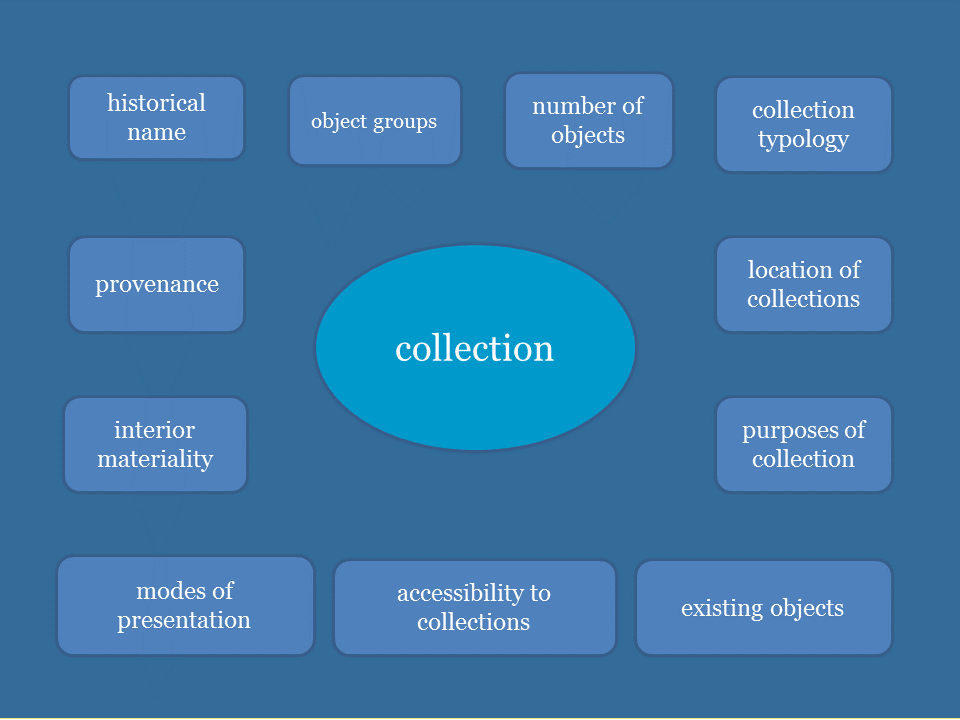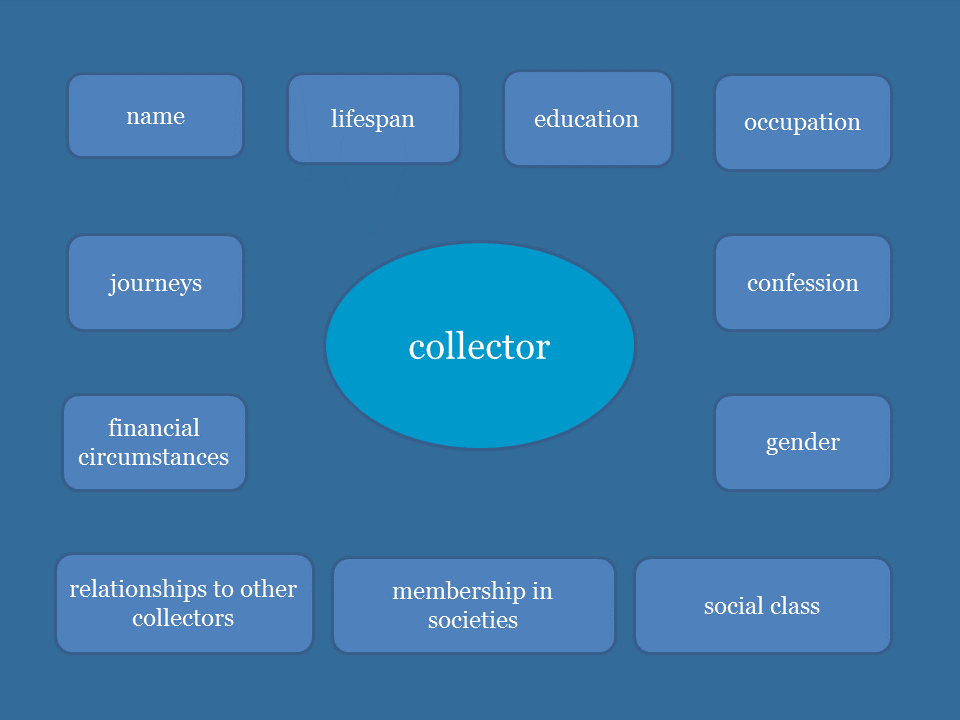Bähr, Astrid: Repräsentieren, Bewahren, Belehren. Galeriewerke (1660–1800). Von der Darstellung herrschaftlicher Gemäldesammlungen zum populären Bildband, Hildesheim 2009.
Becker, Christoph: Vom Raritäten-Kabinett zur Sammlung als Institution. Sammeln und Ordnen im Zeitalter der Aufklärung, Egelsbach 1996.
Blaschke, Karlheinz (Hg.): Geschichte der Stadt Dresden, 3 Bde., Stuttgart 2005/06.
Bredekamp, Horst: Antikensehnsucht und Maschinenglauben. Die Geschichte der Kunstkammer und die Zukunft der Kunstgeschichte, 3. Aufl., Berlin 2007.
Bredekamp, Horst/Brüning, Jochen/Weber, Cornelia (Hg.): Theater der Natur und Kunst. Theatrum naturae et artis, Wunderkammern des Wissens, Berlin 2000.
Brückner, Jenny: „… und ist der Besitzer des allerschönsten Stücks welches der Meister selbst derer hält“. Der Hofmaler Christian Wilhelm Ernst Dietrich und die Sammlung Spahn, in: Dresdener Kunstblätter 55 (2011), 2, S. 91–103.
Brückner, Jenny: Ein vergessener Sammler des 18. Jahrhunderts. Johann Heinrich Christian Spahn und sein Verhältnis zur Dresdener Gemäldegalerie, in: Jahrbuch der Staatlichen Kunstsammlungen Dresden 36 (2010 [2012]), S. 92–101.
Brückner, Jenny: „Ein vornehmer Herr hat ein Kabinett …“. Dresdener Sammler im 18. Jahrhundert, in: Koch/Ruggero 2017, S. 194–211.
Bußmann, Frédéric: Sammeln als Strategie. Die Kunstsammlungen des Prince de Conti im Paris des ausgehenden Ancien Régime, Berlin 2010.
Collet, Dominik: Die Welt in der Stube. Begegnungen mit Außereuropa in Kunstkammern der Frühen Neuzeit, Göttingen 2007.
Dolezel, Eva: Die Logik des Schauraums. Zur Präsentation von Naturalien abseits der Taxonomien, in: Förschler, Silke/Mariss, Anne (Hgg.): Akteure, Tiere, Dinge Verfahrensweisen der Naturgeschichte in der Frühen Neuzeit, Köln/Weimar/Wien 2017, S. 209–224.
Dolezel, Eva: Der Traum von Museum. Die Kunstkammer im Berliner Schloss um 1800 – eine museumsgeschichtliche Verortung, Berlin 2019.
Dolezel, Eva/Godel, Rainer/Pečar, Andreas/Zaunstöck, Holger (Hgg.): Ordnen–Vernetzen–Vermitteln. Kunst-und Naturalienkammern der Frühen Neuzeit als Lehr- und Lernorte, Halle (Saale) 2018.
Döring, Detlev (Hg.): Gelehrte Gesellschaften im mitteldeutschen Raum (1650–1820), 2 Bde., Stuttgart u. a. 2000/02.
Felfe, Robert/Wagner, Kirsten (Hg.), Museum, Bibliothek, Stadtraum. Räumliche Wissensordnungen 1600–1900, Berlin 2010.
Dziekan, Katrin/Pott, Ute (Hg.): Lesewelten – Historische Bibliotheken. Büchersammlungen des 18. Jahrhunderts in Museen und Bibliotheken Sachsen-Anhalts, Halle (Saale) 2008.
Freitag, Werner/Ranft, Andreas (Hgg.): Geschichte der Stadt Halle, Bd. 1: Halle im Mittelalter und in der Frühen Neuzeit, Halle (Saale) 2006.
Geffarth, Renko/Meumann, Markus/Taatz-Jacobi, Marianne/Zaunstöck, Holger: Akademische Geselligkeit und ihre Räume im Halle des 18. Jahrhunderts, in: Görtz, Sebastian (Hg.): Geselligkeiten im 18. Jahrhundert. Kulturgeschichtliche Überlieferung in Museen und Archiven Sachsen-Anhalts, Halle (Saale) 2012.
Grote, Andreas (Hg.): Macrocosmus in Microcosmos. Die Welt in der Stube. Zur Geschichte des Sammelns, 1450 bis 1800, Opladen 1994.
Habel, Thilo: Vom „musaeum Linckianum“ zum Linck-Zimmer, in: Mieth, Katja Margarethe (Hg.), Das Naturalienkabinett. Sammeln, Forschen, Zeigen, Chemnitz 2011, S. 34–41.
te Heesen, Anke/Spary, Emma C.: Sammeln als Wissen. Das Sammeln und seine wissenschaftsgeschichtliche Bedeutung, Göttingen 2001.
Henkel, Riccarda: Die Gesellschaft der freyen Künste zu Leipzig. Eine „Gottschedsche“ Sozietät als Beispiel des aufklärerischen Wissenschaftsdiskurses, Leipzig/Stuttgart 2014.
Heres, Gerald: Dresdener Kunstsammlungen im 18. Jahrhundert, Leipzig 2006.
Hofmann-Polster, Katharina: Der Hof in der Messestadt, Stuttgart 2014.
Hommel, Karsten: „… die ohnehin mehr eingebildeten als reellen Preise der Kunstsachen …“. Ein Beitrag über die Frühgeschichte des Leipziger Kunsthandels, in: Leipziger Stadtgeschichte. Jahrbuch (2012), S. 55–82.
Hommel, Karsten: Kunst- und Naturaliensammlungen, in: John 2016, S. 431–442.
Hommel, Karsten: „Ferner sind die allhiesigen sehenswürdigen Musea nicht mit Stillschweigen zu übergehen.“. Ein Beitrag zur Topografie des Leipziger Sammelwesens in der Frühen Neuzeit, in: Godel/ Pečar/Zaunstöck 2018, S. 121–149.
Hornemann, Dorothea/Veltmann, Claus: „Zu Erziehung der Jugend“. Die Naturalienkammer August Hermann Franckes in der Tradition der frühneuzeitlichen Sammlungs- und Bildungskultur, in: Zaunstöck, Holger (Hg.), Die Welt verändern. August Hermann Francke. Ein Lebenswerk um 1700, Ausst.-Kat. Franckesche Stiftungen 2013, Halle (Saale) 2013, S. 129–143.
Jaeger, Susanne: Alexander S. Stroganov (1733–1811). Sammler und Mäzen im Russland der Aufklärung, Köln 2007.
John, Uwe (Hg.): Geschichte der Stadt Leipzig. Von den Anfängen bis zur Gegenwart, 4 Bde., Leipzig 2015–2019.
Kase, Oliver: Mit Worten sehen lernen. Bildbeschreibung im 18. Jahrhundert, Petersberg 2010.
Kernbauer, Eva: Der Platz des Publikums. Modelle für Kunstöffentlichkeit im 18. Jahrhundert, Köln 2011.
Koch, Ute C./Ruggero, Cristina (Hgg.): Heinrich Graf von Brühl. Ein sächsischer Mäzen in Europa – Akten der internationalen Tagung zum 250. Todesjahr, Dresden 2017.
Koch, Ute C.: Maecenas in Sachsen. Höfische Repräsentationsmechanismen von Favoriten am Beispiel von Heinrich Graf von Brühl, Dresden 2016.
Körner, Stefan: Nikolaus II Esterhazy (1765–1833) und die Kunst. Biografie eines manischen Sammlers, Wien 2013.
Krüger, Ralph: Bürgerliche Sammlungen des 17. und 18. Jahrhundert in Leipzig, in: Topfstedt, Thomas (Hg.), Leipzig um 1800. Beiträge zur Sozial- und Kulturgeschichte, Beucha 1998, S. 113–126.
Laube, Stefan: Privilegierte Dinge für Unterprivilegierte? Die Kunstkammer im Waisenhaus, in: Dolezel/ Godel/Pečar/Zaunstöck 2018, S. 49–72.
Lehmann, Stephan/Ruprecht, Michael (Hgg.): Die akademischen Sammlungen und Museen der Martin-LutherUniversität Halle-Wittenberg, Dresden 2017.
Mencfel, Michał: Den Besitzern zum Ruhm und der gelehrten Welt zum Nutzen“. Die schlesischen Kunst- und Naturalienkammern des 17. und 18. Jahrhunderts, in: Dolezel/Godel/Pečar/Zaunstöck 2018, S. 151–178.
Müller-Bahlke, Thomas J.: Die Einzigartigkeit der Kunst- und Naturalienkammer in den Franckeschen Stiftungen, in: Troitzsch, Ulrich (Hg.): „Nützliche Künste“. Kultur- und Sozialgesichte der Technik im 18. Jahrhundert, Münster/New York/München/Berlin 1999 (Cottbuser Studien zur Geschichte von Technik, Arbeit und Umwelt 13), S. 219–238.
Müller-Bahlke, Thomas: Die Wunderkammer der Franckeschen Stiftungen, 2. Aufl., Halle (Saale) 2012.
Pabstmann, Sven: Rembrandt, Rubens, Permoser – Ruhm und Glanz barocker Kunstsammlungen in Leipzig. Anmerkungen zur Sammlungsgeschichte der Stadt Leipzig um 1700, in: Koch/Ruggero 2017, S. 194–211.
Ruhland, Thomas: Objekt, Parergon, Paratext. Das Linné’sche System in der Naturalia-Abteilung der Kunst- und Naturalienkammer der Franckeschen Stiftungen, in: Knebel, Kristin/Ortlieb, Cornelia/ Püschel, Gudrun (Hgg.): Steine rahmen, Tiere taxieren, Dinge inszenieren. Sammlung und Beiwerk, Dresden 2018, S. 72–105.
Sander, Torsten: Ex Bibliotheca Bunaviana. Studien zu den institutionellen Bedingungen einer adligen Privatbibliothek im Zeitalter der Aufklärung, Dresden 2011.
Savoy, Bénédicte: Zum Öffentlichkeitscharakter deutscher Museen im 18. Jahrhundert, in: dies. (Hg.), Tempel der Kunst. Die Entstehung des öffentlichen Museums in Deutschland 1701–1815, Mainz 2006, S. 9–23.
Schepkowski, Nina Simone: Johann Ernst Gotzkowsky. Kunstagent und Gemäldesammler im friderizianischen Berlin, Berlin 2009.
Schindling, Anton: Bildung und Wissenschaft in der Frühen Neuzeit 1650–1800, 2. Aufl., München 1999.
Schneider, Joachim: Adelslandschaft Mitteldeutschland – Adelslandschaften in Mitteldeutschland? in: Bünz, Enno/Höroldt, Ulrike/Volkmar, Christoph (Hgg.): Adelslandschaft Mitteldeutschland. Die Rolle des landsässigen Adels in der mitteldeutschen Geschichte (15. –18. Jahrhundert), Leipzig 2016, S. 149–168.
Schopferer, Julia: Sozialgeschichte der halleschen Professoren 1694–1806. Lebenswege, Netzwerke und Raum als Strukturbedingungen von universitärer Wissenschaft und frühmoderner Gelehrtenexistenz, Halle (Saale) 2016.
Siemer, Stefan: Geselligkeit und Methode. Naturgeschichtliches Sammeln im 18. Jahrhundert, Mainz 2004, bes. S. 15–48 („Der Sammler im urbanen Raum“).
Segelken, Barbara: Bilder des Staates. Kunstkammer, Kasten und Tafel als Visualisierungen staatlicher Zusammenhänge, Berlin 2010.
Spary, Emma C.: The naturalist collecting community in Paris, 1760–1789, in: Dolezel/Godel/Pečar/ Zaunstöck 2018, S. 297–322.
Stübel, Moritz: Dresdner Privatsammler im 18. Jahrhundert, in: Das Sammlerkabinett 3 (1924/25), 10, S. 1–6.
Valter, Claudia: Studien zu bürgerlichen Kunst- und Naturaliensammlungen des 17. und 18. Jahrhunderts in Deutschland, Aachen 1995.
Whitmer, Kelly J.: The Halle Orphanage as Scientific Community. Observation, Eclecticism, and Pietism in the Early Enlightenment, Chicago 2015.
Zaunstöck, Holger: Sozietätslandschaft und Mitgliederstrukturen. Die mitteldeutschen Aufklärungsgesellschaften im 18. Jahrhundert, Tübingen 1999a.
Zaunstöck, Holger: Die halleschen Aufklärungsgesellschaften im 18. Jahrhundert. Eine Strukturanalyse, in: Donnert, Erich (Hg.), Europa in der Frühen Neuzeit. Festschrift für Günter Mühlpfordt, 5 Bde., Weimar/Köln/Wien 1997–1999, Bd. 5 (1999b), S. 43–63.
Albers, Laura/Grosse, Peggy/Wagner, Sarah: Semantische Datenmodellierung mit CIDOC CRM – Drei Fallbeispiele, in: Eibl, Maximilian/Geadke, Martin (Hgg.): INFORMATIK 2017, Lecture Notes in Informatics (LNI), Gesellschaft für Informatik, Bonn 2017, S. 1209–1220.
DOI: 10.18420/in2017_122
Bender, K.: Distant viewing: a pact with the devil in the paradise of art history, in: Iconography in Art History (Blog), 05.02.2014.
URL: https://kbender.blogspot.com/2014/02/distant-viewing-pact-with-devil.html
Dörk, Marian/Carpendale, Sheelagh/Williamson, Carey: The Information Flaneur: A Fresh Look at Information Seeking, in: CHI 2011. Proceedings of the SIGCHI Conference on Human Factors in Computing Systems, ACM, S. 1215–1224.
DOI: 10.1145/1978942.1979124
HU Berlin: Wissenschaftliche Sammlungen der Humboldt-Universität zu Berlin, 03.04.2019.
Internet Archive: https://www.sammlungen.hu-berlin.de
Oldman, Dominic/Tanase, Diana/Santschi Stephanie: The Problem of Distance in Digital Art History, in: International Journal for Digital Art History, 16.12.2019.
DOI: 10.11588/dah.2019.4.72071
Uni Göttingen: Wissenschaftliche Sammlungen der Georg-August-Universität Göttingen, 17.04.2019.
Internet Archive: https://sammlungen.uni-goettingen.de
Weber, Cornelia (Hg.): Dokumentation zum Projekt „Universitätssammlungen in Deutschland: Untersuchungen zu Bestand und Geschichte“, 10.07.2013.
URL: http://www.universitaetssammlungen.de/download/Projektdokumentation.pdf







